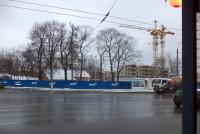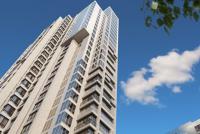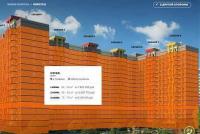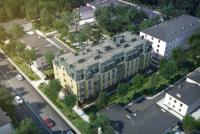Collection of 16 pipelines internal. Building regulations. State Committee of the Russian Federation
FER-2001-16 Pipelines internal
System of regulatory documents in construction
Building regulations
RUSSIAN FEDERATION
Fer 81-02-16-2001
Federal
Single rates
On construction work
FER-2001.
Collection No. 16.
Pipelines internal
Application:
Collection of estimated rates for the operation of building machines
and estimated prices for materials, products and designs
Official edition
State Committee of the Russian Federation
on a construction and housing and communal complex
(Gosstroy Russia)
Moscow 2001
Construction rates and rules 1
Russian Federation 1.
ISBN 5-88737-111-7 3.
Technical part 4.
1. General instructions 4
2. Rules for calculating the volume of work 5
3. The coefficients for single rates 5
Table 16-01-001. Laying in trenches of cast iron pipes pipes 6
Table 16-01-002. Laying on the walls of the buildings and in the channels of pipes of cast-iron pressure ventilated 6
Table 16-01-003. Installation of shaped parts of pig-iron pressure 6
Table 16-01-004. Gasket in trench pipelines from cast iron sewer pipes 6
Table 16-01-005. Laying on the walls of the buildings and in the channels of pipelines from cast-iron sewer pipes 6
Table 16-02-001. Gasket of heating pipelines from steel water-wire-wired non-zero pipes 7
Table 16-02-002. Laying water supply pipelines from steel water-gas pipeline galvanized pipes 7
Table 16-02-003. Gasket pipelines of gas supply from steel water-gas-wires neoscake pipes 7
Table 16-02-004. Laying pipelines of heating and gas supply from steel seamless pipes 8
Table 16-02-005. Laying pipelines of heating and water supply from steel electric welding pipes 8
Table 16-02-006. Laying pipelines strapping boilers, water heaters and pumps from steel seamless and electric weld pipes 8
Table 16-02-007. Installation of flange connections on steel pipelines 9
Table 16-03-001. Gasket of heating pipelines from multilayer metal-lopolymer pipes 9
Table 16-03-002. Laying water supply water supply from multilayer metal-polymer pipes 10
Table 16-04-001. Laying of sewage pipelines from high density polyethylene pipes 10
Table 16-04-002. Laying of water supply pipelines from pressure polyethylene pipes of low pressure of medium type 11
Table 16-05-001. Installation of valves, valves, shutters, reverse valves, cranes of passage on pipelines made of steel pipes 11
Table 16-05-002. Installation of valves, valves, shutters, reverse valves, cranes of passing on pipelines made of cast-iron pressure flanged pipes 11
Table 16-05-003. Installation of safety valves 12
Table 16-05-004. Installation of receiving valves 12
Table 16-05-005. Installation of reducing spring valves 12
Table 16-06-001. Installation of water-gods supplied to the installation site collected into blocks, with waterfront 12
Table 16-06-002. Installation of water grooves supplied to the place of installation assembled into blocks, without a waterline line 12
Table 16-06-003. Device of water grooves with the manufacture of strapping at the installation site, with the waterfront line 13
Table 16-06-004. Device of water gates with the manufacture of strapping at the installation site, without the waterline 13
Table 16-06-005. Installation of meters (water meters) 13
Table 16-07-001. Installation of cranes 13.
Table 16-07-002. Installation of funnel 13.
Table 16-07-003. Boxes in existing internal networks of heating and water supply pipelines 13
Table 16-07-004. Boxes in the current internal networks of sewage pipelines 14
Table 16-07-005. Hydraulic testing of pipelines of heating systems, water supply and hot water supply 14
Table 16-07-006. Sealing the glands when the pipe pass through the foundations or walls of the basement 14
Meter: Seal 14
Collection of estimated rates for operation 15
Building machines and estimated materials for materials, 15
Before the direction of e-treatment in Minstroy Russia, please read the rules of the work of this interactive service below.
1. The consideration is made by electronic appeals in the field of competence of the Ministry of Construction of Russia, completed in accordance with the attached form.
2. The electronic circulation may contain a statement, complaint, offer or request.
3. Electronic appeals directed through the official Internet portal of the Ministry of Construction of Russia are coming to the Department of Citizens. The ministry provides an objective, comprehensive and timely consideration of appeals. Consideration of electronic appeals is free.
4. In accordance with the Federal Law of 02.05.2006, N 59-FZ "On the procedure for considering the appeals of the citizens of the Russian Federation", electronic appeals are recorded during three days and are sent depending on the contents of the ministry in the structural units. Appeal is considered within 30 days from the date of registration. Electronic appeal, which contains questions, the solution of which is not within the competence of the Ministry of Internal Affairs of Russia, is sent within seven days from the date of registration to the appropriate authority or the corresponding official, whose competence includes the decision of the issues issued, with a notice of a citizen who sent an appeal.
5. Electronic circulation is not considered when:
- the absence of the name and applicant's name;
- specifying incomplete or falverate postal address;
- presence in the text of obscene or offensive expressions;
- presence in the text of the threat of life, health and property of an official, as well as members of his family;
- use when set the text of the non-crosslinic layout of the keyboard or only capital letters;
- the absence of punctuation marks in the text, the presence of incomprehensible abbreviations;
- The presence of a question in the text that the applicant has already been given a written response on the merits in connection with previously directed appeals.
6. The response to the applicant's appeal is sent to the postal address specified when filling out the form.
7. When considering the appeal, it is not allowed to disclose the information contained in circulation, as well as information relating to the private life of a citizen, without its consent. Information on personal data of applicants is kept and processed in compliance with the requirements of Russian legislation on personal data.
8. Appeals received through the site are generalized and submitted to the management of the ministry for information. At the most frequently asked questions, answers periodically published in the sections "for residents" and "for specialists"
PART
1. General instructions
1.1. The norms of the collection are applied to work on laying pipelines of internal sanitary systems in residential, public, industrial and auxiliary buildings of industrial enterprises, regardless of the materials of walls, overlaps and partitions, including:
separate household and drinking and fireproof water supply pipes, as well as united economic and drinking, fire-fighting and industrial water pipes to 1.6 MPa (16 kgf / cm 2);
hot water supply;
heating with coolants water with a temperature of up to 150 ° C and pairs of pressure to 0.07 MPa (0.7 kgf / cm 2);
separate and combined household and industrial (for non-aggressive drainage) sewage, internal drains;
low pressure gas supply
These norms should be used when laying pipelines in boiler rooms equipped with cast-iron sectional and steel boilers with a capacity of up to 1.16 MW (1 Gcal / h) with water temperature up to 115 ° C and a steam pressure not higher than 0.07 MPa (0.7 kgf / cm 2) and pipelines of thermal points with water heaters with the surface of heating to 30 m 2 or with a capacity of up to 6 m 3 each.
Laying pipelines in boiler and heat points with higher parameters, as well as pipelines of pumping, filter and sewage stations of water supply and sewage systems are normalized by appropriate collection of equipment installation rates.
1.2. The internal pipelines include the inputs of the water supply and sewage editions deployed from the outer wall of the building to the first well.
1.3. The norms provide a full range of basic and auxiliary work on the laying, installation and attachment of the corresponding elements of pipelines, including the acquisition, markup of the gasket locations and drawing sketches, installation and removal of rigging devices, drilling or punching holes for fasteners, moving the cylinders during welding and T . P.
1.4. The diameters of pipelines and reinforcement are given in the tables of norms on the conditional passage.
1.5. Laying pipelines is provided in the presence of ready -sted holes in the walls, overlaps and partitions. Seeling holes after the passage of pipelines of the collection standards is not taken into account.
1.6. Laying pipelines made of steel water-gas, seamless and welded pipes with a diameter of up to 200 mm, cast-iron sewer and plastic on the walls of the buildings and channels, as well as pipelines of the strapping of boilers, water heaters and pumps are provided from finished pipelines supplied to the installation site by transportable nodes; From steel seamless and welded pipes with a diameter of more than 200 mm, cast-iron pressure pipes and cast-iron sewer pipes in trenches - with the use of individual pipes and fittings.
Sewer releases and sewage pipelines inside the building in trenches are normalized by software.
1.9. Laying pipelines and installation of fittings are provided at an altitude of up to 3 m from the floor. When working at greater height, the norms are applied to the norms.
The device, in accordance with the project of the production of works, forests or solid flooring, should be normalized by the collection of 8 "structures of brick and blocks".
2. Rules for the calculation of work volumes
2.1. The scope of pipeline laying should be determined:
from cast-iron pressure pipes - along the length of the pipes. The mass of the shaped parts is accepted by project data;
from cast-iron sewer and plastic pipes - according to the design length of pipelines without deduction of sections occupied by the shaped parts and reinforcement;
from steel water-gas, seamless and welded pipes - according to the design length of pipelines minus sites occupied by P-shaped compensators.
2.2. The amount of work on the laying of pipelines of the strapping of boilers, water heaters and pumps is determined by the project length of pipelines located within the unit to the point of connecting them to the supply and discharge networks.
Do not be included in the scope of work of pipelines of the strapping of nodes of water-operated, elevator, manual pumps, condensate traps, as well as pipelines of individual ones and distribution comb, taken into account in the relevant comprehensive standards of collections on internal sanitary and technical devices.
2.3. The number, type and dimensions of the valves installed on pipelines are determined by project data. At the same time, fittings are not included in the scope of work, which is included in the supply of heating boilers, capacitive water heaters, coupling components and manual pumps, coupling fittings of elevator nodes, as well as all reinforcement, installed within the water components.
2.4. The volume of work on hydraulic testing of steel pipelines is determined by the design length of all pipelines of the system, including P-shaped compensators and sections occupied by shaped parts and reinforcement.
Collection 16.
Pipelines internal
This collection includes norms and rates for the execution of work on the laying of pipelines of domestic sanitary systems in residential, public, industrial and auxiliary buildings of industrial enterprises, regardless of the materials of the walls, overlaps and partitions, including:
separate systems of economic and drinking and fireproof water pipes, as well as the combined systems of economic and drinking, fire-fighting and industrial water pipes by pressure to 1.6 MPa (16 kgf / cm2);
hot water systems;
heating systems under coolants: water temperature up to 150 degrees. C and pairs of pressure up to 0.07 MPa (0.7 kgf / cm2);
separate and combined systems of household and industrial (for non-aggressive drainage of sewage;
internal drains;
low pressure gas supply systems;
entering water supply and sewage releases deployed from the outer wall of the building to the first well.
The norms and rates of the collection should be used when laying pipelines in boiler rooms equipped with cast-iron sectional and steel boilers with a capacity of up to 1.16 MW (1Hcal / h), water temperature up to 115 degrees. With and a steam pressure not higher than 0.07 MPa (0.7 kgf / cm2) and pipelines of thermal points with water heaters with high-speed surface of the heating of one section up to 30 m2 or capacitive capacity up to 6 m3 each.
The costs of laying pipelines in boiler and thermal points with higher parameters, as well as pumping pipelines, filter and sewage stations of water supply and sewage systems are determined by the standards and rates of collection 12 on the installation of equipment "Technological pipelines".
In the norms and rates of this collection, there is a full range of basic and auxiliary work on the laying, installation and accession of the corresponding elements of pipelines, including their acquisition, markup of the laying places and draw sketches, installation and removal of rigging fixtures. In the norms and rates of tables 16-5 - 16-11, 16-13, the costs of drilling holes for fastenings and supports under pipelines, on the installation and sealing of the sleeves in the places of crossing pipes with overlaps, walls and partitions are not taken into account.
Normal and rates are not provided for the cost of wrapping with rolled materials and plastering polyethylene pipes in places of crossing them with walls and overlaps. These costs are determined additionally under the project data.
Laying pipelines is provided in the presence of ready-through holes in the walls, partitions and overlaps. Inserting holes after the passage of the pipeline with norms and rates of the collection is not taken into account.
In norms and rates for laying pipelines from steel water-gas pipes, seamless and electric welded diameters up to 150 mm, cast-iron sewer pipes on the walls of buildings and in channels, polyethylene sewer pipes, polypropylene pipes of water supply systems, as well as strapping of boilers, water heaters and pumps are provided by the use of ready-made nodes of pipelines supplied to the place of installation by transportable nodes.
Laying pipelines made of iron pressure pipes, cast-iron sewer pipes in trenches, steel seamless and welded pipes with a diameter of over 150 mm, pressure polyethylene pipes, steel galvanized pipes on fittings and polypropylene pipes of water supply systems, polypropylene pipes of sewage systems are adopted using individual pipes and fittings .
When laying pipelines from water-water pipes and pipelines, strapping boilers, water heaters and pumps are taken into account of pipelines supplied with installed reinforcement. The amount, the type and diameter of the reinforcement is accepted by project data, and its cost is determined additionally.
Conducts and rates are taken into account the costs of installing fittings with manual control, flywheel.
Installing fittings with other drives is normalized by a collection of 12 standards and rates for installation of equipment "Technological pipelines".
The costs of laying the installation of water pipes from cast-iron pipes are determined by the standards and rates of tables 16-1 - 16-3, and the supply of water pipes from steel pipes - according to standards and rates of table 16-9.
Territorial estimated standards for Moscow TSN-2001
Chapter 3.
CONSTRUCTION WORKS
Collection 16.
Pipelines internal
TSN-2001.3-16
Territorial estimated standards for Moscow considered by the Interdepartmental Council on Provision Policy in Construction under the Government of Moscow (Minutes of September 25, 2006 No. MS-9-06), entered into force from December 1, 2006 by Decree of the Government of Moscow dated November 14, 2006 No. 900 -PP "On the order of transition to the definition of the estimated cost of construction of facilities in the city of Moscow using territorial estimated standards at the price level as of January 1, 2000"
|
Technical part 1. General instructions 3. Factors to estimated standards and rates Section 1. Pipelines made of cast-iron pressure pipes Table 16-1. Gasket in trenches of cast iron pipes Table 16-2. Laying on the walls of buildings and in the channels of pipes of cast-iron pressure pouring Table 16-3. Installation of shaped parts of cast iron pressure Section 2. Pipelines made of cast iron sewer pipes Table 16-4. Laying in trench pipelines from cast iron sewer pipes Table 16-5. Gasket on the walls of the buildings and in the channels of pipelines from cast-iron sewer pipes Section 3. Pipelines made of steel water-gas pipes Table 16-6. Laying pipelines heating from steel water-gas pipes neoscake pipes Table 16-7. Laying water supply pipelines from steel water-gas-wire galvanized pipes Table 16-8. Gasket of gas supply pipelines from steel water-gas pipes neoscake pipes Section 4. Pipelines made of steel seamless and welded pipes Table 16-9. Gasket of heating pipelines and gas supply from steel seamless pipes Table 16-10. Gasket of heating and water supply pipelines from steel electric welding pipes Table 16-11. Laying pipelines strapping boilers, water heaters and pumps from steel seamless and electric welding pipes Table 16-12. Installation of flange connections on steel pipelines Section 5. Pipelines made of plastic pipes Table 16-13. Laying pipelines sewage from PVC pipes Table 16-14. Installation of flexible supply to water-based fittings and laying pipelines from pressure polyethylene pipes Table 16-31. Laying the pressure pipe from metal plastic pipes Section 6. Flange Pipeline Armature Table 16-15. Installation of valves, valves, shutters, reverse valves, cranes of passing on pipelines made of steel pipes Table 16-16. Installation of valves, valves, shutters, reverse valves, cranes of passage on pipelines made of cast-iron pressure flange pipes Table 16-17. Installation of safety valves Table 16-18. Installation of receiving valves Table 16-19. Installation of reducing spring valves Section 7. Fire and Watering Cranes Table 16-20. Installing cranes Section 8. Wardrons drain and drain Table 16-21. Installation of the funnel Section 9. Watermarks and water meters (counters) Table 16-22. Installation of water-gods supplied to the place of installation assembled into blocks, with bypass line Table 16-23. Installation of water grooves supplied to the place of installation assembled into blocks, without a bypass line Table 16-24. Installation of water grooves with the manufacture of strapping at the installation site, with the waterfront line Table 16-25. Installation of water grooves with the manufacture of strapping at the installation site, without a waterfront line Table 16-26. Installing meters (water meters) Section 10. Box in the current internal networks Table 16-27. Boxes in existing internal networks of heating and water supply pipelines Table 16-28. Boxes in the current internal networks of sewage pipelines Section 11. Hydraulic Pipeline Testing Table 16-29. Hydraulic testing of pipelines of heating systems, water supply and hot water supply Section 12. Sealing the glands Table 16-30. Sealing the glands when passing pipes through the foundations or walls of the basement Section 13. Other works Table 16-32. Installation of mines-package in the running conditions Table 16-33. Installation of fireproof couplings on sewer risers |
Technical part
1. General instructions
1.1. Norms and rates of this collection are applied to work on laying pipelines of domestic sanitary systems in residential, public, industrial and auxiliary buildings of industrial enterprises, regardless of the materials of walls, overlaps and partitions, including:
1.1.1. Separate systems of economic and drinking and fireproof water supply systems, as well as the combined systems of economic and drinking, fire and production water supply to 1.6 MPa (16 kgf / cm 2).
1.1.2. Hot water systems.
1.1.3. Heating systems for coolants: water temperature up to 150 ° C and steam pressure to 0.07 MPa (0.7 kgf / cm 2).
1.1.4. Separate and combined systems of household and industrial (for non-aggressive drainage) sewage.
1.1.5. Internal drainage.
1.1.6. Low pressure gas supply systems.
1.1.7. Entering water supply and sewage releases deployed from the outer wall of the building to the first well.
These norms and rates should be used when laying pipelines in boiler rooms equipped with cast-iron sectional and steel boilers with a capacity of up to 1.16 MW (1 Gcal / h) water temperature up to 115 ° C and a steam pressure not higher than 0.07 MPa (0.7 kgf / cm 2) and pipelines of heat points with water heaters with high-speed with the surface of the heating of one section up to 30 m 2 or capacitive capacity up to 6 m 3 each.
The cost of laying pipelines in boiler and thermal points with the equipment of higher parameters, as well as pipelines of pumping, filter and cleaning stations of water supply and sewage systems are determined by the collection of 12 rates for the installation of equipment "Technological pipelines".
1.2. The norms and rates of the collection provides for a full range of basic and auxiliary work on the laying, installation and attachment of the corresponding elements of pipelines, including their acquisition, layout of gasket places and drawing sketches, installation and removal of rigging devices, drilling or punching holes for fasteners, installation of fasteners and supports under pipelines with welding or targeting them to carrying structures or mortgage parts, installation and fixing the sleeves in places of crossing steel and plastic pipelines with overlaps, walls and partitions, moving cylinders in the process of welding and the like.
The cost of fasteners and supports by norms and rates is not taken into account and is determined additionally under the project data. The norms and rates are also not provided by wrapping with rolled materials and plastering polyethylene pipes in the places of crossing them with walls and overlaps. These costs are defined in estimates in addition to project data and appropriate collections.
1.3. The diameter of pipelines and reinforcement, except for the norms and rates of the table. 16-14, is given by conditional passage.
1.4. Laying pipelines is provided in the presence of ready-through holes in the walls, partitions and overlaps.
Seeling holes after passing pipelines by norms and rates of the collection are not taken into account.
1.5. Laying pipelines made of steel water-water, seamless and welded diameter up to 150 mm, cast-iron sewer pipes on the walls of buildings and in channels, sewer PVC pipes, as well as pipelines of strapping boilers, water heaters and pumps are provided from finished pipelines supplied to the place of installation by transportable nodes;
from steel seamless and welded pipes with a diameter of more than 150 mm, cast-iron pressure and cast-iron sewer pipes in trenches - with the use of separate pipes and separately shaped parts.
1.6. When laying pipelines from water-water pipes and pipelines, strapping boilers, water heaters and pumps are taken into account of pipelines supplied with installed reinforcement. The amount, type and diameter of reinforcement are accepted by project data, and its cost is determined in the estimates additionally.
1.7. The norms and rates of the collection take into account the cost of installing fittings with manual control, flywheel.
Installation of fittings with other drives is regarded by a collection of 12 rates for installation of equipment "Technological pipelines".
1.8. The cost of laying the installation of water pipes from cast iron pipes is determined by the standards and rates of the table. from 16-1 ÷ 16-3, and the inputs of water pipes from steel pipes - according to the standards and rates of the table. 16-9 and 16-10.
The laying of sewage issues and sewage pipelines inside the building in trenches is determined by the standards and rates of the table. 16-4.
1.9. Standards and rates table. 16-6, 16-7, 16-9 and 16-10 are taken into account the costs of installing P-shaped compensators.
1.10. Normally and the rates 16-20-1 provide for the cost of installing a fire crane. The cost of arranging fire crane (locker, door, etc.) are determined in the estimates to the construction part of the project.
1.11. Standards and rates table. 16-30 costs are provided only on the sealing of the glands during the passage of pipes through the foundations or walls of the basement.
Installation of glands is taken into account in the rates of the respective collections on building structures.
1.12. Laying pipelines and installation of fittings are provided at an altitude of up to 3 m from the floor or solid flooring, when operating at a greater height, the coefficients shown in section 3 of the technical part are used.
1.13. The cost of the device, in accordance with the project of the production of works, forests or solid flooring, is determined by the standards and rates of the collection of 8 "structures of brick and blocks"
1.14. The costs of protecting the roof of the funnel of internal drainage and sewage risers are taken into account in the norms and rates of the collection of 12 "roofs".
2. Rules for the calculation of work volumes
2.1. The scope of pipeline laying should be determined:
2.1.1. Of the cast iron pressure pipes - along the length of the pipes, the mass of the shaped parts is taken according to the project data.
2.1.2. From cast-iron sewer and PVC pipes - according to the design length of pipelines without deducting areas occupied by the shaped parts and reinforcement.
2.1.3. From steel water-gas, seamless and welded pipes - according to the design length of pipelines without deduction of sections occupied by the shaped parts, reinforcement and P-shaped compensators.
2.2. The volume of work on the laying of pipelines of the strapping of boilers, water heaters and pumps is determined by the design length of pipelines located within the unit, to the point of connecting them to the supply and discharge networks.
2.3. Do not be included in the scope of work of pipelines of the strapping of nodes of water, elevator, manual pumps, condensate trap, as well as distribution comb pipelines, taken into account in the relevant comprehensive standards provided by collections on internal sanitary and technical devices.
2.4. The amount, type and diameter of the reinforcement installed on pipelines is determined by the project data, while the work is not included in the scope of work, which is included in the supply of heating boilers, capacitive water heaters, condensate and manual pump components, coupling fittings of elevator nodes, as well as all reinforcement , installed within the water grooves.
2.5. The volume of work on hydraulic testing of steel pipelines is determined by the design length of all pipelines of the system, including P-shaped compensators and sections occupied by shaped parts and reinforcement.






